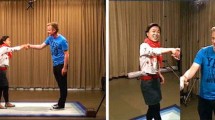Abstract
This paper deals with a multimodal annotation scheme dedicated to the study of gestures in interpersonal communication, with particular regard to the role played by multimodal expressions for feedback, turn management and sequencing. The scheme has been developed under the framework of the MUMIN network and tested on the analysis of multimodal behaviour in short video clips in Swedish, Finnish and Danish. The preliminary results obtained in these studies show that the reliability of the categories defined in the scheme is acceptable, and that the scheme as a whole constitutes a versatile analysis tool for the study of multimodal communication behaviour.



Similar content being viewed by others
Notes
We follow here Duncan (2004) who defines a gesture as a movement that is always characterised by a stroke, and may also go through a preparation and a retraction phase. Each stroke corresponds in MUMIN to an independent gesture.
References
Allwood, J. (2001). Dialog Coding—function and grammar. Gothenburg Papers. Theoretical Linguistics, 85. Department of Linguistics, Gothenburg University.
Allwood, J. (2001b). The structure of dialog. In M. Taylor, D. Bouwhuis, & F. Nel (Eds.), The structure of multimodal dialogue II (pp. 3–24). Amsterdam: Benjamins.
Allwood, J., & Cerrato, L. (2003). A study of gestural feedback expressions. In P. Paggio et al. (Eds.), Proceedings of the First Nordic Symposium on Multimodal Communication (pp. 7–22).
Allwood, J., Nivre, J., & Ahlsén, E. (1992). On the semantics and pragmatics of linguistic feedback. Journal of Semantics, 9, 1–26.
Allwood, J., Cerrato, L., Dybkjær, L., Jokinen, K., Navarretta, C., & Paggio, P. (2004). The MUMIN multimodal coding scheme. Technical Report availale at http://www.cst.dk/mumin/. CST, University of Copenhagen, Denmark.
Bailly, G., Elisei, F., Badin, P., & Savariaux, C. (2006). Degrees of freedom of facial movements in face-to-face conversational speech. In Proceedings of the LREC 2006 workshop on multimodal corpora (pp. 33–37). Genoa, Italy.
Bernsen, N. O., Dybkjær, L., & Kolodnytsky, M. (2002). The NITE workbench—a tool for annotation of natural interactivity and multimodal data. In Proceedings of LREC 2002 (pp. 43–49).
Cassell, J. (2000). Nudge nudge wink wink: Elements of face-to-face conversation for embodied conversational agents. In J. Cassell et al. (Eds.), Embodied conversational agents (pp. 1–27). Cambridge, MA: MIT.
Cerrato, L. (2007). Investigating communicative feedback phenomena across languages and modalities. PhD Thesis in Speech and Music Communication, Stockholm, KTH.
Cerrato, L. (2004). A coding scheme for the annotation of feedback phenomena in conversational speech. In J. C. Martin et al. (Eds.), Proceedings of the LREC 2004 workshop on models of human behaviour (pp. 25–28).
Clark, H. H., & Schaefer, E. F. (1989). Contributing to discourse. Cognitive Science, 13, 259–294.
Cowie, R. (2000). Describing the emotional states expressed in speech. In Proceedings of the ISCA workshop on speech and emotion (pp. 11–19).
Craggs, R., & McGee Wood, M. (2004). A categorical annotation scheme for emotion in the linguistic content of dialogue. In Affective dialogue systems. Proceedings of Tutorial and Research workshop, Kloster Irsee, Germany, June 14–16. Lecture Notes in Computer Science (pp. 89–100). Berlin, Heidelberg: Springer
Duncan, S. (2004). Coding manual. Technical Report availale from http://www.mcneilllab.uchicago.edu.
Duncan, S. Jr., & Fiske, D.W. (1977). Face-to-face interaction: Research, methods and theory. Lawrence Erlbaum Associates Publishers: Wiley.
Ekman, P. (1999). Basic emotions. In T. Dalgleish & M. Power (Eds.), The handbook of cognition and emotion (pp. 45–60). NY: Wiley.
Ekman, P., & Friesen, W. V. (1978). Facial action coding system. Palo Alto: Consulting Psychologist Press.
Ekman, P., & Friesen, W. V. (2003). Unmasking the face: A guide to recognizing emotions from facial cues. Cambridge, Massachusetts: Malor Books.
Gunnarsson, M. (2002). User manual for multiTool. Technical Report availale from http://www.ling.gu.se/mgunnar/multitool/MT-manual.pdf.
Harrigan, J. A., Rosenthal, R., & Scherer, K. R. (2005). The new handbook of methods in nonverbal behavior research. New York: Oxford University Press.
Kendon, A. (2004). Gesture. Cambridge: Cambridge University Press.
Kipp, M. (2001). Anvil—A generic annotation tool for multimodal dialogue. In Proceedings of Eurospeech 2001 (pp. 1367–1370).
Krippendorff, K. (2004). Content analysis: An introduction to its methodology (2nd ed.). Beverly Hills, CA: Sage Publications.
McNeill, D. (1992). Hand and mind: What gestures reveal about thought. Chicago: University of Chicago Press.
Peirce, C. S. (1931). In C. Hartshorne & P. Weiss (Eds.), Elements of logic. Collected papers of Charles Sanders Peirce (Vol. 2.). Cambridge: Harvard University Press.
Rietveld, T., & van Hout, R. (1993). Statistical techniques for the study of language and language behaviour. Berlin: Mouton de Gruyter.
Spooren, W. (2004). On the use of discourse data in language use research. In H. Aertsen, M. Hannay, & R. Lyall (Eds.), Words in their places: A festschrift for J. Lachlan Mackenzie (pp. 381–393). Amsterdam: Faculty of Arts.
Steininger, S., Schiel, F., Dioubina, O., & Rabold, S. (2002). Development of user-state conventions for the multimodal corpus in SmartKom. In Proceedings of the workshop ‘Multimodal Resources and Multimodal Systems Evaluation’ 2002 (pp. 33–37). Las Palmas, Gran Canaria, Spain: ELRA.
Sikorski, T. (1998). Improving dialogue annotation reliability. In Working notes of the AAAI spring symposium on applying machine learning to discourse processing. March. http://www.cs.rochester.edu/u/sikorski/research/s98aaai.html.
Thórisson, K. R. (2002). Natural turn-taking needs no manual: Computational theory and model, from perception to action. In G. Granström, et al. (Eds.), Multimodality in language speech systems (pp. 173–207). Dordrecht, the Netherlands: Kluwer Academic.
Author information
Authors and Affiliations
Corresponding author
Rights and permissions
About this article
Cite this article
Allwood, J., Cerrato, L., Jokinen, K. et al. The MUMIN coding scheme for the annotation of feedback, turn management and sequencing phenomena. Lang Resources & Evaluation 41, 273–287 (2007). https://doi.org/10.1007/s10579-007-9061-5
Received:
Accepted:
Published:
Issue Date:
DOI: https://doi.org/10.1007/s10579-007-9061-5




